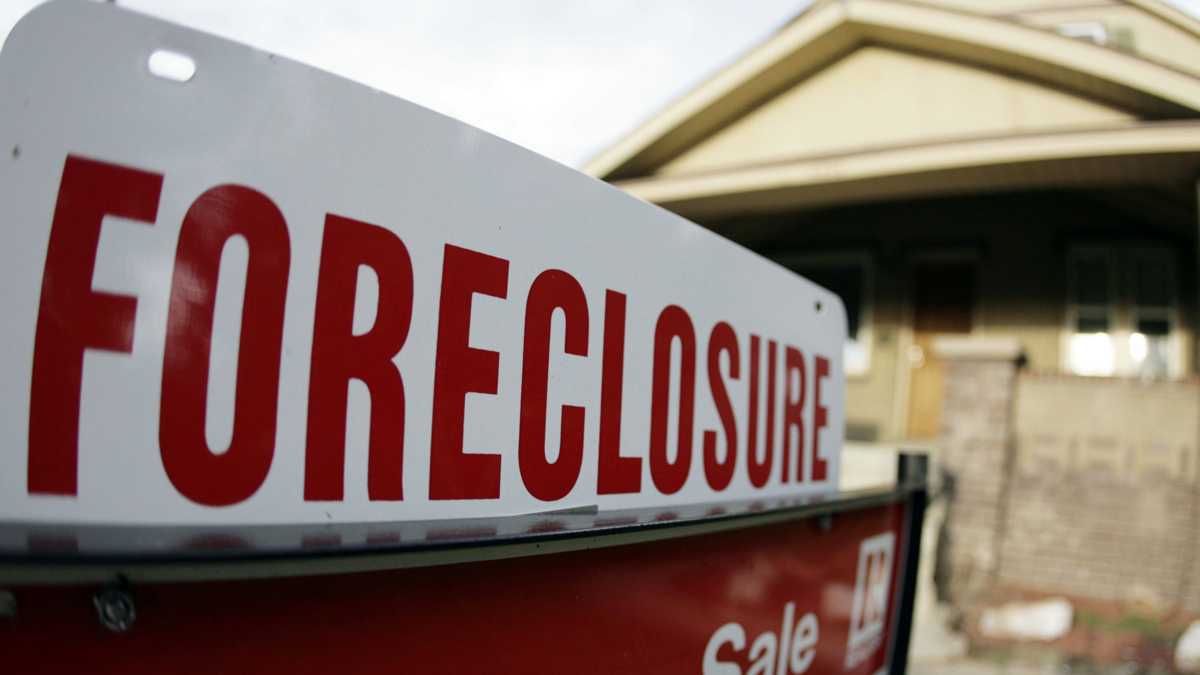New Jersey’s housing market improves but foreclosures still high

(David Zalubowski/AP Photo)
Even as real-estate agents see encouraging demand for Shore rentals, and home prices in parts of New Jersey creep gradually higher, analysts and academics say foreclosures continue to slow the state’s housing market and economy.
In some areas, such as previously fast-growing counties on the suburban fringe or long-depressed urban areas, low prices may be precursors of lasting economic change, according to the experts.
While the overall numbers have improved, New Jersey continues be among the leaders in both foreclosures and mortgages in trouble. Home values, which in much of the country have rebounded strongly since the Great Recession, continue to tread water in much of the state.
In some communities, the picture is worse. Atlantic City and Trenton rank first and second in the nation for foreclosures. Beyond those obvious sore spots, observers point to areas like Ocean County, where they say the twin blows of the recession and superstorm Sandy may be changing the long-term dynamics of the real estate market.
High rates of cash sales of property in these areas suggest large investors making speculative purchases are replacing individual home buyers as driving forces in those markets, analysts said. They foresee one result as more rentals, fewer owners with strong links to the communities.
In the midst of preparing his firm’s latest, generally cheerful overview of housing trends around the nation, Daren Blomquist, a vice president of RealtyTrac of Irvine, CA, agreed to take a closer look at New Jersey markets.
“In many ways what we’re seeing in those areas, and for New Jersey overall, is running counter to the positive national trend,” Blomquist said. “There are still a lot of foreclosures, a lot of distressed mortgages and prices remain well below the pre-recession peaks.”
By RealtyTrac’s reckoning, median home prices reached their peak in New Jersey at $350,000 in July 2007, a bit later than most of the nation. Even after a jump in March, they are now at $265,000, 24.3 percent lower, the firm reported.
The numbers vary, but CoreLogic, another Irvine, CA, real-estate analytics firm, agrees that New Jersey is lagging. In April, it reported the state’s average housing prices rose by 1.6 percent during the previous year. But that gain was less than 46 other states and the District of Columbia. For the nation, the increase was 6.8 percent, CoreLogic found.
“NJ has experienced a high foreclosure rate and large number of distressed sales that have slowed home-value improvement,” said Frank Nothaft, CoreLogic’s chief economist.
Another housing-data firm, Seattle-based Zillow, calculated that housing values have dropped 11 percent in Atlantic City in 12 months, and 26.7 percent of mortgages there have negative equity, debt higher than the property value.
The problems extend beyond the city. Egg Harbor and Pleasantville were both down more than 7 percent, according to the firm. Dennis and Woodbine townships in Cape May County both saw double-digit drops in home values, though based on fewer sales. In Cumberland County, Bridgeton homes are worth only an average of $68,300, but their prices are also falling.
In Mercer County, Zillow showed the average value of a Trenton home is $83,000, down 1.4 percent. Prices are nearly twice as high in Neighboring Hamilton Township, but they dropped 1.9 percent, the firm found.
In Newark, where for a time housing values were coming back slightly faster than the state average, recent CoreLogic report shows them stagnant or receding, down half a percent in the most recent findings.
In contrast, housing data from the firms show Philadelphia prices rising 29 percent. Brooklyn has become one of the least-affordable places in the country compared to its historic norms. The New York City area as a whole, including Jersey City, saw a 4.3 percent year-over-year price increase.
Asked to assess these trends, Professor Charles Steindel of Ramapo College, the state’s former chief economist, pointed to the same culprit in the problem areas. “Foreclosures are still high” in much of the state, he said.
But Steindel added he is “a little encouraged that home prices are falling” in some of those places. To an extent, that reflects properties moving through foreclosure and coming to market at lower prices, he said. “The number of (new) cases is finally coming down,” Steindel said, creating a path toward potential improvement.
Figures from state courts buttress that view. Through mid-April, lenders have filed about 11,000 foreclosure cases this year. That’s well above the pre-recession pace of about 20,000 a year, but far down from the peak of 63,000 in 2009.
While several others agreed with Steindel, they repeatedly used one phrase to describe the continuing effect of the glut of foreclosures on the housing market here.
“It’s like watching the nature special, when a snake eats an animal and you see the pig moving through the python,” said Peter Reinhart, director of Monmouth University’s Kislak Real Estate Institute. “We’re finally seeing the end of that bulge, but it’s a long, slow process.”
Like about half the states, New Jersey requires courts to approve foreclosures, with the properties then going through county sheriff’s departments for disposition.
That process generally takes years, particularly after instances of fraudulent documents and testimony in some cases caused state Chief Justice Stuart Rabner to order major lenders to clean up their acts in December 2010. Foreclosures slowed to a trickle over the next nine months as banks sought to demonstrate their procedures are proper.
Ask real-estate agents and others in the industry about New Jersey housing, and you will get an earful about how Rabner’s “moratorium” created a backlog of foreclosures that continues to clog the market.
Of course, the long time period theoretically should have allowed banks to reach accommodations with borrowers, such as modifying mortgages bought at inflated prices to reflect the current, lower values of the homes. But that seldom happened here, analysts said.
“Two of our members who had been struggling recently were able to modify their mortgages,” said Amanda Devecka-Rinear of the New Jersey Organizing Project, who works with residents displaced by superstorm Sandy. “But in 18 months, they’re the first ones.”
“You’re not really seeing banks offering many modifications,” Blomquist said. “Those that were for a time generally did it to meet the requirements of their settlements with the federal government” over mortgage-fraud allegations. “But they’ve satisfied those terms, and even the federal (mortgage) aid programs are coming to an end, so there’s no incentive to do more,” he said.
In New Jersey, the sheriff’s sales process has another effect, Reinhart said, effectively removing affected property from the consideration of individual buyers. “Very rarely does anybody go to a sheriff’s sale looking for their new home,” he said.
Instead, mortgage holders are lining up other institutional buyers, some with long horizons, perhaps waiting for prices to rise before returning them to market, or converting single-family houses to apartments to accommodate those displaced from their homes by foreclosure.
But this spring, there is also plenty of optimism about a turnaround, particularly in Shore rentals. Superstorm Sandy in late October, 2012, devastated some communities, washing away homes, roads, and other structures.
The result was tough times, according to Eric Birchler, the owner of a family real-estate brokerage in Lavallette, Seaside Park, and Ortley Beach, virtually ground zero for storm damage. The following year “was the worst I can remember,” he said. “Summer rentals were down 60 percent and sales down substantially.” Some of his usual properties were gone, others uninhabitable or inaccessible.
But more people came back in 2014 and 2015, he said. This year, properties are increasing as well, Birchler said.
“We’ve got a lot of people who are rebuilding, and are renting out to help pay for it,” he said.
That is helping both to meet demand and keep rents stable, Birchler said. He has “100 percent confidence” that new or rebuilt homes will withstand future storms. But he noted another change, one that has attracted attention from observers beyond the Shore.
Since Sandy, “the 600-square-foot bungalows are no longer there,” he said. Replacing them are “buildings that are on pilings, with four bedrooms, 2½ baths on top,” Birchler said. “Financially, it’s better to build a house that’s bigger,” at least for those who can afford it, he said. But not everyone can, he said.
“There’s a lot of people that built their homes 30, 40 years ago, or inherited them,” Birchler said. With tougher codes and flood-insurance requirements, “it takes a major cash infusion to rebuild.” Some people simply get worn out from fighting with insurers and government agencies, he said.
“It is changing the demographics,” Birchler said.
The analysts agree him: as long-time owners leave, their replacements may be something completely different.
________________________________________________________
NJ Spotlight, an independent online news service on issues critical to New Jersey, makes its in-depth reporting available to NewsWorks.
WHYY is your source for fact-based, in-depth journalism and information. As a nonprofit organization, we rely on financial support from readers like you. Please give today.




